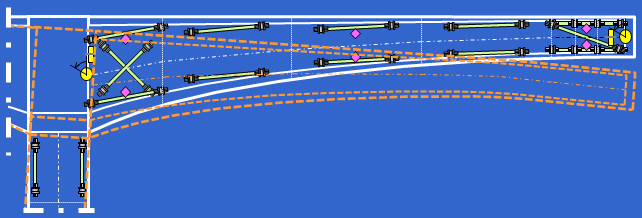
| Course CEE 439/539: Structural Health Monitoring (SHM) |
|
INTRODUCTION |
Needs for optimization of maintenance costs, increase of safety, and continuous developments of new construction materials and methods, as well as recent technological developments in various branches of science and engineering led to creation of this relatively new, interdisciplinary branch of engineering – Structural Health Monitoring. This course introduces the topics with basic definitions of measurement and monitoring, monitoring activities and entities, and with various available and emerging monitoring technologies. The fundamental criteria for applications on concrete, steel and composite materials are elaborated, and basics on data interpretation and analysis for both static and dynamic monitoring are presented. Finally, methods applicable to large spectrum of civil structures, such as bridges, buildings, geo-structures, and large structures are developed. Each lecture of the course is illustrated with examples taken from the practice. The course is offered to both graduate students and undergraduate students of higher years (juniors and seniors). A fair knowledge in Construction Materials, Structural Analysis, and Engineering Mathematics is expected from participants. The homework and hands-on will be based on Streicker Bridge project and other various real projects.
|
CURRICULUM |
1) Introduction to structural health monitoring: basic notions, needs, and benefits; smart/intelligent structures. 2) The structural health monitoring process: core activities and entities (actors); example of structural health monitoring project. 3) Monitoring systems: basic notions on measurement; requirements and available technologies; classification of deformation sensors by gage-length; static and dynamic monitoring. 4) Deformation sensors: sensor gage-length and measurement; short-gage vs. long-gage sensors; determination of gage-length limits; distributed sensors; tilt-meters; displacement sensors. 5) Strain and deformation components: strain components and strain time evolution; elastic and plastic (structural) strain; thermal strain, creep, and shrinkage. 6) Interpretation of measurements: sources of errors; determination of strain components and stress from strain measurement; detection of anomalous structural condition – model-based and model-free approaches. 7) Dynamic monitoring: sources of dynamic behavior; accelerometers; handling and storage of data; sampling frequency and aliasing; system identification and modal analysis. 8) Global and integrity monitoring: introduction to global monitoring concept; simple, parallel, crossed, and triangular topologies; integrity monitoring. 9) SHM strategies 1: monitoring of bridges – simple beam, continuous girder, arch, cable stayed, and suspension bridge. 10) SHM strategies 2: monitoring of pile foundations; monitoring of buildings; monitoring of heritage structures. 11) SHM strategies 3: monitoring of dams, tunnels, and pipelines. 12) Monitoring other parameters: corrosion, fatigue, humidity and pH of concrete, weather, etc.
|
SAMPLE READING LIST(under development) |
1) Glisic, B. and Inaudi, D., Fibre Optic Methods for Structural Health Monitoring, John Wiley & Sons, Inc., 2007, ISBN 978-0-470-06142-8
|
COURSE SCHEDULE |
Tuesdays and Thursdays, 8:30AM - 9:20AM, Room To Be Determined
|